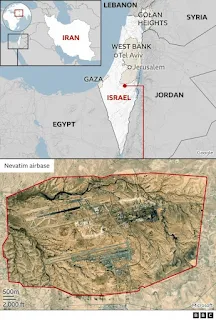What was in the air in the wave of Iranian attacks and how were they stopped?
For the first time, Iran has attacked Israel.
In the middle of saturday night, air raid alerts were issued in israel, residents were urged to seek shelter as explosions were heard and air defenses were put on alert.
barricades were in the night sky in several areas across the country, with dozens of drones and missiles being shot down by Israel's allies before reaching Israeli territory.
Read this : An Israel youth was found dead in the west bank
at least nine countries were involved in the military attack - with missiles launched from Iran, Iraq, Syria and Yemen and downed by Israel, the United States, France and Jordan.
The attacks involved drones, cruise and ballistic missiles
Iran fired more than 300 drones and missiles at Israel, the Israeli military said on Sunday.
.The attacks included 170 drones and 30 missiles, none of which entered Israeli territory, and 110 ballistic missiles, a small number of which reached Israeli territory, army spokesman Rear Admiral Daniel Hagari said in a statement to television channel.The BBC has not independently verified the figures.
The shortest distance from Iran to Israel is about 1,000 km (620 miles) across Iraq, Syria and Jordan.
Invasion was launched from several countries
on Saturday night Iran's Revolutionary Guards Corps (IRGC) said it had fired drones and missiles.
Read this : Scientists are learning to speak whale language
Iraqi security sources told Reuters that missiles were seen flying over Iraqi airspace towards Israel.
The iRGC said the ballistic missiles were fired about an hour after the slow-moving drones so they could attack Israel at about the same time.
The US Department of Defense has said that US forces intercepted dozens of missiles and drones launched from Iran, Iraq, Syria and Yemen.
The Iranian-backed Hezbollah group in Lebanon also said it fired two missiles at an Israeli military base in the occupied Golan Heights that Israel captured from Syria in a move that has not been recognized by most of the international community
Israel and its allies have intercepted a large number of drones and missiles
About 99 percent of the attacks that were launched were intercepted outside Israeli airspace or on the ground itself, Admiral Daniel Hagari said.
they included drones and missiles, which follow a flat trajectory, and multiple ballistic missiles, which are launched on a trajectory that uses traction to achieve very high speeds.
Read this: Israel army has announced new measures how to bring humanitarian aid into gaza
US President Joe Biden said US forces "helped Israel shoot down almost all" of the drones and missiles fired by Iran on Sunday. in his statement, he said the United States moved aircraft and warships in the area before the unprecedented attack.
U.S. forces operating in undisclosed bases in the area shot down several Iranian drones in southern Syria near the border with Jordan, security sources told Reuters.
British RAF Typhoon fighter jets were also sent to shoot down drones. They flew over the skies of Iraq and Syria but not over Israel.
Jordan - which has a peace treaty with Israel but has been highly critical of the way it has waged its war against the Palestinian group Hamas in Gaza - also intercepted flying objects that entered its airspace to protect the safety of its citizens, Jordan's cabinet said in a statement. his statement.France helped patrol the airspace but it was unclear whether they shot down drones or missiles, the Israeli military said.
How many missiles went into Israeli territory and what damage did they cause?
in Jerusalem BBC reporters reported hearing sirens and seeing Israel's Iron Dome missile defense system in action, which uses radar to track rockets and can distinguish between those likely to hit built-up areas and those not.
interceptor missiles are only fired at rockets intended to attack populated areas.
A few ballistic missiles passed and attacked Israeli territory, Adm. Hagari said.
One of them "slightly hit" the Nevatim air force base in the Negev desert in southern Israel. Adm. Hagari said the army camp "is still working".
Iran's official IRNA news agency said the attack was a "major blow" to the air force base.
In total, about 12 people were injured on the Israeli side, Adm. Hagari said









 Itsnlife group
Itsnlife group
No comments:
Post a Comment